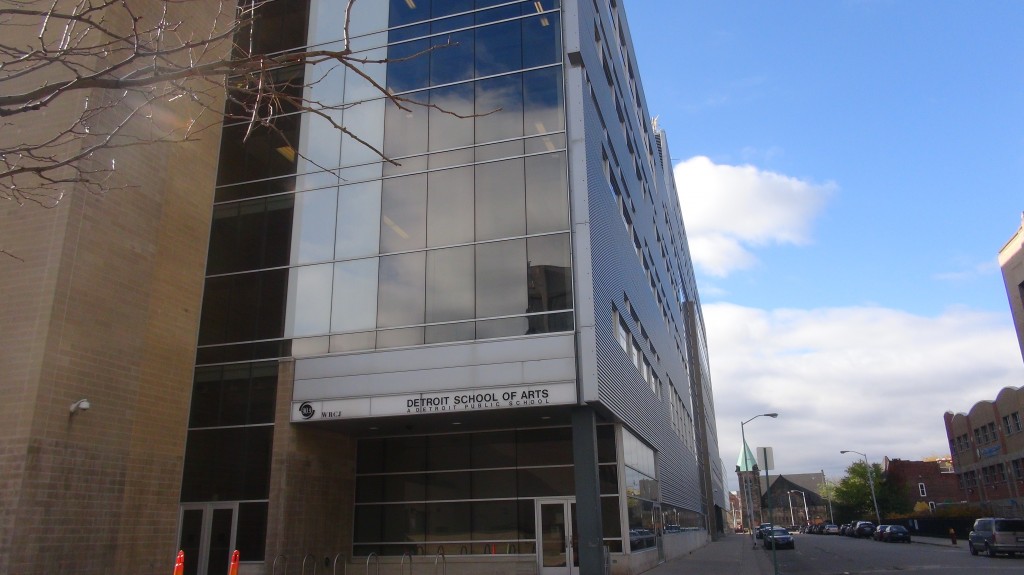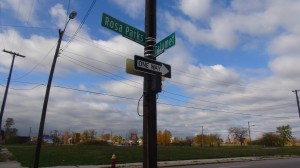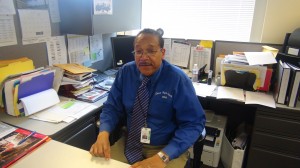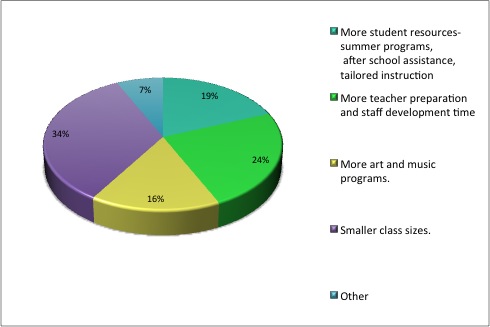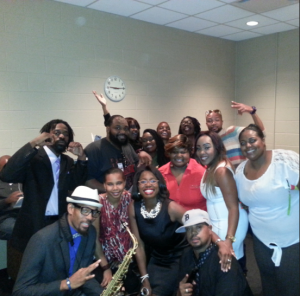The Detroit Schools of Arts (DSA) in Midtown Detroit, formerly known as the Detroit High School for the Fine and Performing Arts, is a part of the Detroit Public School District. This high school (9th-12th grade) focuses on five performing arts elements: Dance, Instrumental, Radio/TV, Visual Arts, and Vocal.
Merriam-Webster Dictionary defines fine art as an activity that requires skill and care. The fine arts could begin at a young age. For some, that introduction started at home with our parents, one parent may have been a musician themselves while the other would play the sounds of great artist like the Jackson Five, Wynton Marsalis, and Duke Ellington, to name a few. For some, the introduction could have been a trip to the museum to see the likes of Vincent VanGogh, Pablo Picasso, or Frida Kahlo. For another child, it could be the Saturday or weekday ballet classes to learn different positions to one day become a prima ballerina, such as Janet Collins. No matter where it started it made an impact in a young child’s life where they wanted to continue that journey to one day become a world-renowned artist by their own merit.
DSA was founded in fall of 1992 by now retired-principal of 18years, Dr. Denise Davis Cotton.
“The vision and mission was to ensure that inner city youth had school access and to an arts, academic, comprehensive college preparatory education. To also ensure that after DSA Achievers, the name I gave to the children as our mascot. I felt they would be Achievers in school and in life and as productive citizens in society,” stated Cotton.
“So the vision to ensure Detroit youth had an opportunity to succeed in an environment that supported the arts, that nurtured their creativity, their intelligence on all levels, right brain and left brain. To ensure that everyone in the school who had contact with the students understood that their mission was to continue to nurture and develop a young artist and their ambition,” said Dr. Cotton.
To hear more from the interview, you can listen here:
Once located at “4333 Rosa Parks Blvd.,” the school opened its doors in 1992 to its first freshman class of 90 students. In the winter of 2005, the school relocated to its new home on 123 Seldon St.
At the start of the 2013-2014 school year; students were welcomed with fewer fine arts programs included in their class schedule. Four arts teachers were transferred to other schools within the Detroit Public School System, because of low enrollments numbers. While the school is in a 5million deficit, the importance of the arts in the Detroit School of Arts seem to be a non-factor when it comes to keeping curriculum based programs.
In a recent statement to Fox 2 Detroit: Detroit Public School Emergency Manager Jack Martin had this to say, “In recent years, DSA has consistently operated at a deficit that the District can no longer afford to cover, therefore consideration is being given to eliminating some instructional positions and having DSA’s newly restructured leadership team perform both their administrative work and take on some instructional responsibility based on proven models. All of these administrators are licensed and qualified in the respective areas of instruction which they may take on.”
DSA is currently one of nine schools a part of the self-governing council and are a part of the 90/90/21 Promise. Which currently, 90% of all seniors will graduate by 2016. 90% of all graduates will enroll in a post-secondary program and the average ACT score will be 21 by the class of 2020.
With departments such as the Fine Art Department within the Detroit Public School can’t assist the school in its current state. This department, run by Willie McAllister, has been with the district for 35yrs.
“Our department, can not contribute to DSA monetarily, the are currently operating as a self-governing school. As a self-governing school, they research and acquire the funds to help keep the programs running, repairing the instrument, to name a few,” said McAllister.
A study was taken in 2009 with the Louisiana Department of Education, Baton Rouge, Louisiana regarding The Effects of High Stakes Testing Policy on Arts Education stated, “Study of the arts contributes to the development of such twenty-first-century skills as imagination, creativity, and innovative. Effective learning environments and experiences also further this development (Jackson and Davis 2000).”
Cheryl Valentine, a vocal music instructor of over 31 years has been with DSA since 1998. She expressed her thoughts and concerns about the current state of DSA.
“The ninth graders are coming out on the losing in because they are not getting the basics they need that first year.” With the loss of an eighth hour, students now only have two elective in the arts at DSA.
“Detroit has to get back to having art education back in the elementary and middle schools, as in the days of the Motown era,” said Valentine.
When asked does academics and the arts go together? She had this to say, “We are constantly teaching academics…to count a rhythm they have to know math”.
To hear more from the interview, you can listen here:
https://soundcloud.com/reneeaaronevents-1/cheryl-valentine-interview
Research tells us that to compete in a global economy, we must think beyond the linear, logical, and analytical skills that are easily measured by standardized tests (Christensen, Horn, & Johnson 2008).
Three weeks into the school year, Robert Harvey, school director sat down with alumni to discuss the current state of the school as well as help encourage alumni to get involved.
Harvey states, “ We had a 98% attendance rate, the third week of school, that’s amazing… out of the nine self- governing school the average attendance is 81%. The arts motivates students to come to school, they believe in the product we’re providing.”
On November 14, 2013, Principal Harvey invited some alumni to speak with the music appreciation class in which he teaches. With the lack of teachers, he has taken on the duty as teacher as well.
A research study was performed with 8,000 students in the fifth grade, Cognition and Student Learning through the Arts stated, “Even more recently, Stevenson and Deasy (2005) found that the arts allow students to become more engaged in school and learn to make meaning of the world from different perspectives, helping them make sense of other kinds of information. Stevenson and Deasy further note that the arts and non-arts content and skills are best taught in tandem, with the content and methods of the disciplines woven together for mutual reinforcement. This approach places students in active and meaningful roles in the classroom and connects the schools to the students’ own lives and cultures, (Melnick, Whitmer, & Strickland 2011)”.
In the 2013-2017 DPS Strategic Plan Goal/Objective Summary released on April 4, 2013, the school districts shows in Objective 3 the goal is to offer broad/high quality programs. Below are their main objectives.
Objective 3.2: set a District-wide standard for student contact hours in art and music using alternative delivery methods and expand career education opportunities. The availability of art and music and other elective programs has been difficult for DPS to offer consistently as imperatives to maintain test scores and declining resources have challenged instrument funding and time.
Objective 3.3: Implement a longer school year/day, improved summer programs and consider Year-Round Education. Lengthening the school year and day has been proven by researchers as one of the best ways to improve the performance of urban students.
This graph includes the data pulled from the DPS strategic plan.
The Detroit School of Arts when it opened its doors back in the 1992 held a rigorous schedule of 9hrs, which made for an extended day. Within the past five years the school day has shortened the dismissal ending at 3:15pm instead of the former 5pm dismissal.
It shows that the Detroit Public School District has the solution in their plan, so now the implementation stage needs to begin. It also proves that though arts education in primary education opening again, this opens the door of opportunity for the emerging young artist wanting to continue their learning in a school where they are surrounded with their craft everyday.
Objective 11.1: Retain and increase enrollment and market share. In order to maintain enrollment and the associated per pupil revenue that comes with students, the District must work to retain and increase enrollment and maintain its markets share…DPS should identify successful programs that can be expanded and identify ways to attract more students. Providing enterprises services that other school providers can utilize is a potential opportunity for the district.
With this new objective, this will then lead to the possibility of increased enrollment. With increases enrollment, this leads to more teachers to help instruct students not just artistically, but academically as well. The balance should help regain its true state of fine arts and academics being taught under the same roof.
Alumni such as Kristopher Thomas gave his thoughts on the current state of DSA, but he also pledges to help improve and aid to turn the school around. With the help of many others, Kristopher and the other alumni were able to raise over $2000 to help DSA, by giving a showcase back in September. They are currently working on an art exhibit in 2014.
A recent article gives the perfect answer in A Recipe for Artful Schooling. Educational Leadership stated, “Create not only lifelong learners, but also lifelong yearners who can creatively transform almost any assignment, any job, any life circumstance into something of greater value,” (Booth 2009).
